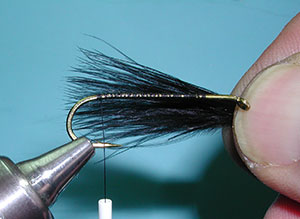
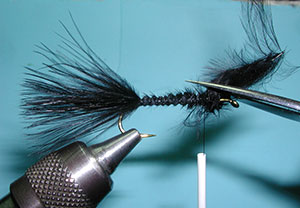
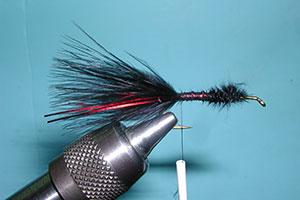
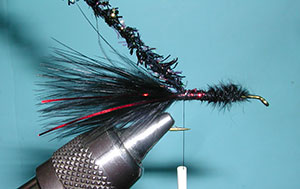

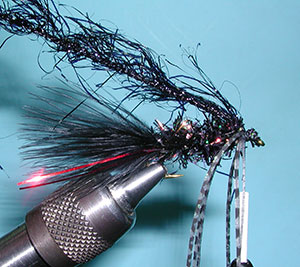
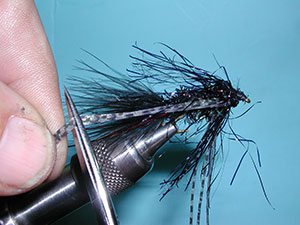
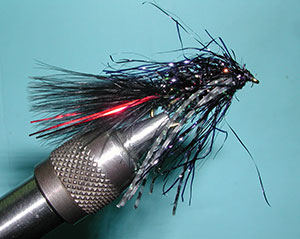

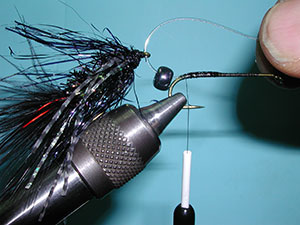

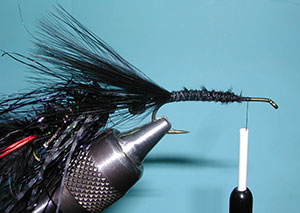


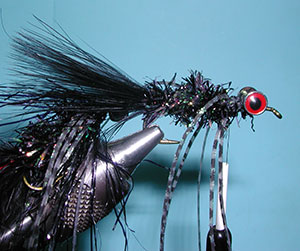
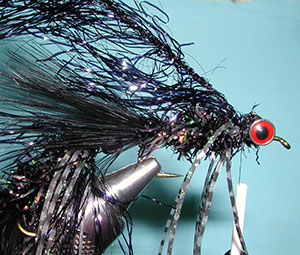
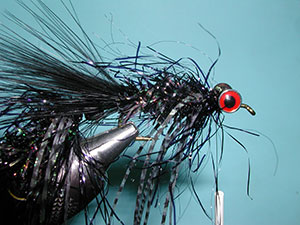
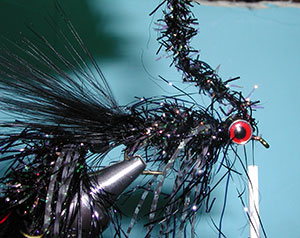
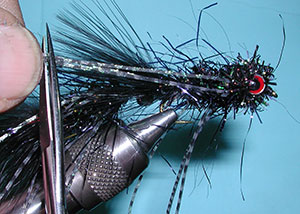
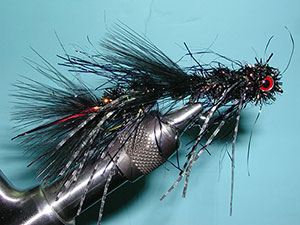
| 1. Attach the back hook to the vise and select a full blood marabou feather. Measure the feather from the bend of the hook to the hook eye. This will be your tail length. |
 |
|
| 2.Place the marabou at the bend of the hook and secure with a few tight wraps and spirol wrap over the tag end of the marabou to about the 3/4 position. Try to keep the material on the top of the shank as you spirol forward with your thread. Clip off the excess. |
 |
|
|
3. For accent, attach a few strands of flashabou along each side of the tail, trimming the flashabou so that it does not exceed the tail length. |
 |
|
| 4. Attach a strand of Krystal Chenille to the tail tie in position. First remove some of the flash material to expose the inner core. It is the inner core or thread of the chenille that gets locked onto the shank with thread wraps. |
 |
|
| 5.Wrap the chenille up to the 3/4 position of the hook shand and secure with thread wraps. Trim off the excess. Next, attach 3sets of barred grizzly legs to the top of the shank in front of the chenille body. Youi should have three strands draped over one each side of the shank. Place a few wraps anchoring the base of the strands to the side of the chenille body |  |
|
|
7. Russ used schlappen as a hackle and collar on this pattern but it was tied in much larger sizes. Here, we are adapting the pattern to smaller hook sizes and I am using Polar Reflector Chenille for a collar hackle. Attach just the core strand in behind the eye of the hook. |
 |
|
|
8. Take two full turns of the Reflector Chenille for a collar and secure with thread wraps. Trim off the excess. Next, trim the legs so that they do not exceed the body length. |
 |
|
|
9. Finish the head and whip finish. Apply some head cement.
|
 |
|
|
10. Place the front hook in the vise. This is a size larger than the back hook and it will have more weight. Lay a thread foundation and secure a strand of 25 lb. Monofilament to the top of the shank just in front of the bend of the hook. Secure with thread wraps and apply zap a gap to the wraps. |
 |
|
|
11. Thread a glass bead and then the back fly going under the eye of the hook. |
 |
|
|
12. Adjust the length of your connector loop so that the back hook has plenty of movement but still close to the bead. Secure the tag end of the monofilament along the side of the monofilament that was first secured. Wrap with thread and apply the Zap a Gap. Trim off the excess. |
 |
|
|
13. A tip of marabou, on honk shank in length is attached at the top of the bend of the hook. This serves as an overwing that hides the connector strand. Secure the tag end of the marabou to the top the hook shank just past the midpoint. |
 |
|
|
14. Next attach the dumbbell eyes to the top or the bottom of the hook shank about two eyelengths back behind the eye. Having the dumbell eyes on the top of the shank will turn the fly upside down and the hooks will be upright. Coat the thread wraps with Zap a Gap on the top and bottom of the dumbbell eye. |
 |
|
| 15. Attach the Krystal Chenille by the core at the tail tie in position. |
 |
|
|
16. Wrap the chenille forward leaving room for the legs to be attached behind the eye. Attach three strands of legs to the top of the shank behind the eye so that three strands drape on both sides. |
 |
|
| 17. Attach the Polar Chenille behind the eye with several thread wraps. |
 |
|
| 18. Wrap the Polar Chenille twice for a collar and secure. |
 |
|
| 19.Attach a last strand of Krystal Chenille in front of the eye and wrap figure eights over and under the dumbell eye filling the void. Secure in front of the eye with thread wraps and trim off the excess. |
 |
|
| 20. Trim the front legs so that they do not exceed the overwing. |
 |
|
| 21. The finished Circus Peanut. |
 |
©2023 Steve Schalla
This page is not to be copied without
my explicit permission.